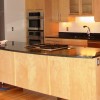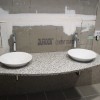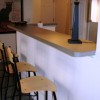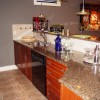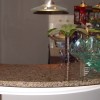Countertops
Video
alt="" How To Install Granite With Undermount SinkCountertops are horizontal work surfaces which are used in all types of construction. In whatever space they are used, countertops become an integral part of the overall aesthetics, and so should be carefully selected to complement the style of cabinets, flooring, wall surfaces and other materials in the room. Countertops are typically supported by cabinets and are most commonly used to provide work space for food preparation in residential and commercial kitchens.
While the standard kitchen countertop is 25" deep and 36" tall, countertop depths and heights will vary between project types, depending on the intended use or application. Countertops often have a backsplash installed along the adjacent wall to prevent damage to the wall from spilled liquids. They may have an integral sink, or be drilled or cut to allow for installation of vessel, drop-in or undermount sinks, as well as cooktops and other appliances or accessories. Depending on the countertop material used, there are many different edge treatments to choose from, such as bullnose, bevel, waterfall, wood trim, or square edges.
Countertops should be impervious to water and stains, as well as resistant to heat, cuts, and scratches, especially when used in kitchens. Some special applications may also require surfaces with chemical and impact resistance or low electrical conductivity. A wide variety of materials are used to manufacture countertops in different thicknesses, at various costs, with a variety of performance and appearance characteristics.
Materials used to manufacture countertops include concrete, metal, wood, plastic laminate, stone, simulated stone, glass, tile and paper. Countertops can also be a composite product made from recycled materials such as paper, glass, or aluminum. Metals used in countertops include stainless steel, aluminum, copper and zinc. Wood used in countertops is typically a hardwood species, which can be categorized as a chopping surface, hardwood butcher block, or non-chopping surface wood such as teak, cherry, walnut and mahogany. Stone materials used in countertops include granite, limestone, slate, marble, soapstone, gabbro and semi-precious stones. Simulated stone countertops are man-made products such as cultured stone, solid surface, quartz, lavastone, fiber cement and resin composites.
When considering which countertop material is best suited for your next project, you should take into consideration aesthetic attributes such as color, pattern, consistency, sheen, and texture, as well as the countertop's intended use. Then define your requirements in terms of material durability and resistance characteristics such as scratching, chipping, cracking, staining and heat. After deciding upon the countertop's needed and desired characteristics, you should have an understanding of the ongoing maintenance requirements for specific materials that you are considering, and how feasible it is to repair these materials. With so many options available for countertops, it is possible to find the right product that fits within your budget for your new construction or renovation project.
See also: Granite Countertops - Should You Cook Wearing A Lead Apron?

Buildipedia Staff
The Buildipedia research and writing staff consists of dozens of experienced professionals from many sectors of the industry, including architects, designers, contractors, and engineers.
Website: buildipedia.com/
